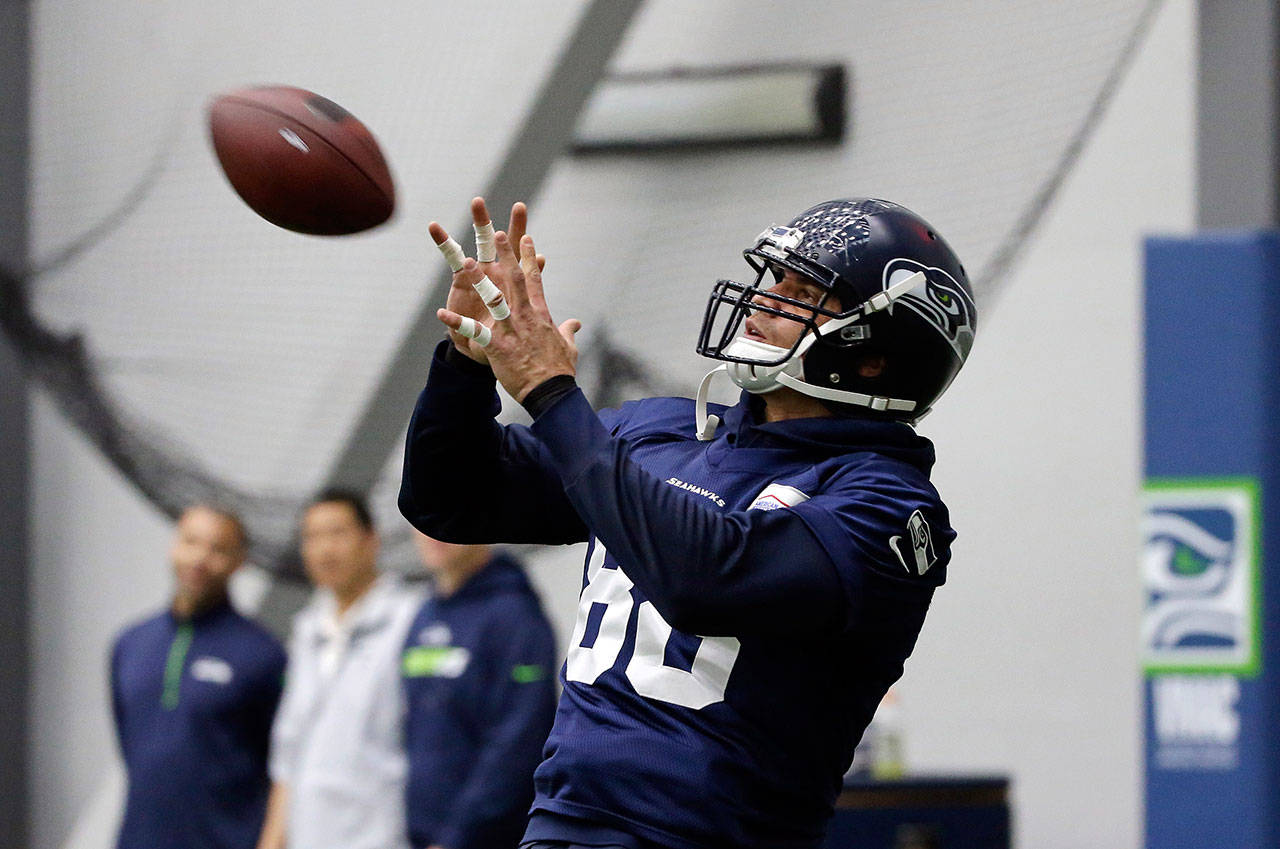RENTON — Jimmy Graham was flying around during the Seattle Seahawks’ offseason practices.
Literally flying around.
Heck, the private pilot flew from his offseason home in Florida just to get to the workouts.
Even teammate Kam Chancellor wants to fly like Graham.
But will the 30-year-old star tight end continue soaring when Graham begins the final season of his $40 million contract in September?
His Seahawks coach absolutely thinks so. Is counting on it, even.
Pete Carroll was asked after Seattle’s final practice of minicamp and the offseason last week who stood out the most this spring.
The first words of Carroll’s response: “Jimmy’s offseason is a big highlight for us.”
“Last year at this time we didn’t know what he was going to be like (for the season). We were positive (in our hopes), but we didn’t know,” Carroll said. “He had a phenomenal offseason with us. His preparation to get here was just terrific.”
Last year at this time, Graham was completely grounded.
“To have to learn how to walk again, it’s humbling,” he said.
The NFL’s most prolific pass-catching tight end from 2012-14 was six months into recovering from tricky surgery to repair a torn patellar tendon in his right knee, the injury he got in November 2015 against Pittsburgh. That prematurely ended his debut season in Seattle after his trade from New Orleans.
Most medical experts consider the recovery from a torn patellar tendon and reconstruction to be more complicated than from more common torn knee ligaments. Some who have torn their patellar tendons, such as New York Giants receiver Victor Cruz (whom Graham consulted in 2016), have taken multiple years to get back to approaching their former selves.
How far back is Graham to his former self? How far back is Graham to being the weapon for quarterback Russell Wilson the Seahawks acquired from the Saints for two-time Pro Bowl center Max Unger and a first-round draft pick in March 2015?
“He’s so much more of a complete player than maybe we thought he would even become, really,” Carroll said. “So, he surprised us. He and Russell are really tuned in. They spend a lot of time together.”
Including working out this offseason together playing pitch and catch on fields in Southern California.
“They communicate beautifully,” Carroll said.
Yet so far the results of that link have been below what the Seahawks thought they would be getting after they traded for Graham.
It’s not that he hasn’t been the 80- or 90-catch guy he was with Drew Brees and the Saints. He never was going to be that in Seattle’s offense. He’s gotten a fraction of the targets he got in New Orleans. And the Seahawks have run the ball the last two seasons with Graham 107 more times (904 total rushes in 2015-16) than New Orleans did its final two seasons with him and Brees together.
Seattle traded to get Graham specifically to fix its problems in the red zone. The season before the trade, the Seahawks ranked 20th in the NFL in scoring touchdowns inside the opponents’ 20-yard line. That’s a rate of 51.5 percent.
But two seasons later, Graham is still lacking the requisite opportunities to truly make a difference around the goal line.
In 2015, when Graham played 11 games before suffering the knee injury, the Seahawks were 16th in red-zone TD scoring, at 55.6 percent. In 2016, they sank to 25th, scoring touchdowns just 47.6 percent of the time while inside the opponents’ 20.
Yes, even though Graham set Seahawks records for tight ends with 65 catches and 923 yards last season, Seattle’s offense was four percentage points worse in red-zone efficiency than in the 2014 season that prompted Seattle to trade for him.
Why?
The Seahawks simply haven’t used Graham enough near the goal line.
In 2015, Wilson was still seeking chemistry with his new tight end. Wide receiver Doug Baldwin shared the NFL lead with a Seahawks-record 14 touchdown catches. Marshawn Lynch was still the lead runner and team’s identity, just before his injuries and eventual retirement. And Graham was not used to breaking off his routes to match Wilson’s improvisational scrambles.
So, Seattle targeted Graham in the red zone nine times in 11 games in 2015, netting three receptions, one touchdown (of 1 yard, in his first Seahawks game, at St. Louis in September 2015) and one interception. Wilson had a passer rating of 39.8 when targeting Graham inside the 20 that season. Graham’s two touchdown catches overall that year were a career low.
Familiarity in year two, 2016, should have spawned red-zone success. But Graham’s rehabilitation from surgery lasted into September. Wilson didn’t throw to him in the red zone until the third game, against San Francisco. Graham’s two-touchdown night against Buffalo Nov. 7, when he twice caught passes one-handed in the end zone while a defender was holding his other arm, showed what a weapon Graham is near the goal line.
But that those two TDs against the Bills were as many red-zone scores as Graham had in the final seven games of 2016 combined.
“I think it will hopefully show up as we get closer to the end zone, (which has been) not quite as productive as we thought we could be,” Carroll said of the Graham-Wilson connection in 2017.
“But that’s a big area of focus for us now.”
Talk to us
> Give us your news tips.
> Send us a letter to the editor.
> More Herald contact information.

























